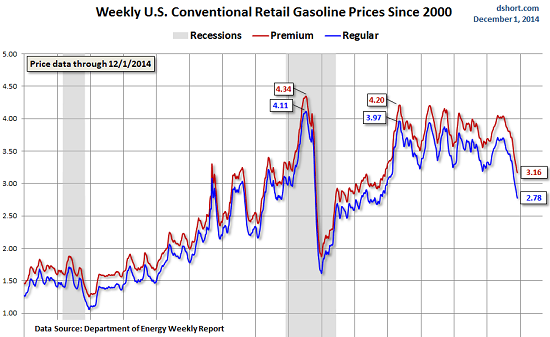American drivers have been breathing a collective sigh of relief. The chaos in the oil markets has translated into lower fuel costs at the pump.
Regular gasoline dropped $0.04 to $2.78 per gallon on average across the US last week, and premium dropped $0.04 to $3.16 per gallon, according to data from the US Energy Information Administration. The last time we saw these kinds of prices was in October 2010.
This chart from Doug Short’s weekly report on gasoline prices shows the last two price peaks in 2011 and 2008 – and the current and very welcome swoon at the pump:
The cheapest gasoline can be had in Missouri ($2.45 per gallon), with Mississippi, South Carolina, Oklahoma, and Texas running close behind, according to GasBuddy.com. As just about always, Hawaii is by far the most expensive state to buy gas in, at $3.86 per gallon. Compared to which the fifth most expensive state, California, at $3.05, looks outright affordable.
And my beloved and crazy city of San Francisco, where you’re better off walking than driving, gas budged down half a measly cent to $3.23 per gallon, the third most expensive city in the country, behind Anchorage in the oil-state of Alaska and Honolulu in Hawaii.
Saving 40 to 50 cents per gallon compared to last year at this time certainly makes you feel better. When you pump 15 gallons into your tank, you save between $6.00 and 7.50, and that’s fabulous. But in an economy where per-capita consumption of gasoline has been declining for years, it no longer has the same per-capita impact on spending for other things.
So despite the drop in gasoline prices, which should have boosted the urge to spend all this saved moolah on other things, retail spending in stores and online over the four-day Thanksgiving weekend, according to the National Retail Federation, dropped 11%. Which makes you wonder about the promises by every economist in the book that lower gasoline prices will translate into higher spending at the mall and Amazon.
That mantra of growth has become the centerpiece of the recent G-20 meeting in Australia. And so here are my favorite down under comedians with their brief but hilarious video takedown of the G-20… Comedians Clarke & Dawe Spoof G-20 Mantra of ‘Growth’
Enjoy reading WOLF STREET and want to support it? You can donate. I appreciate it immensely. Click on the mug to find out how:
![]()



Only losers spend money in stores. Winners take all the gas savings and put it all on the stock market.
Retail spending is down b/c customers are broke. They have to pay housing costs, education costs (to have a chance at a better job like bartender instead of waiter), health insurance cost (a big one), plus carrying costs on all the debt taken on to obtain the forgoing. Something has to be put onto the chopping block and that is discretionary spending — gasoline.
Less consumption of Chinese goods = fewer dollars flowing overseas = pricier dollars = greater tendency to hang onto dollars-in-hand. Dollars are worth more relative to crude … and everything else, too. Loser = Chinese consumer = less of a bid on crude.
With customers around the world looking for help there is no support for high oil prices = decreased rate of extraction, which relies on the money flows.
Indeed, real crude prices rise relentlessly but drillers and their customers live in the ‘nominal world’, in the immediate moment. Their debts are nominal as well.
Too early to make this call; the NTF numbers are notoriously inaccurate as they aren’t based on hard data.
My guess is that sales numbers, once available early 2015, will be pretty flat. However margins will suffer due to heavy discounting.
(Thanks for a great blog)